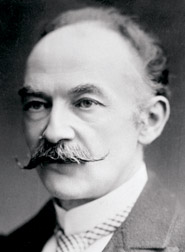Life of Thomas Hardy
Samara Lakshmi Wijewardena
Thomas Hardy was an English novelist and poet. While his works
typically belong to the Naturalism movement, several poems display
elements of the previous Romantic and Enlightenment periods of
literature, such as his fascination with the supernatural.
While he regarded himself primarily as a poet who composed novels
mainly for financial gain, during his lifetime he was much better known
for his novels, such as Tess of the d’Urbervilles and Far from the
Madding Crowd, which earned him a reputation as a great novelist. The
bulk of his fictional works, initially published as serials in
magazines, were set in the semi-fictional land of Wessex (based on the
Dorchester region where he grew up) and explored tragic characters
struggling against their passions and social circumstances.
 |
|
Thomas
Hardy |
Hardy’s poetry, first published in his fifties, has come to be as
well regarded as his novels and has had a significant influence over
modern English poetry, especially after The Movement poets of the 1950s
and 1960s cited Hardy as a major figure.
Thomas Hardy was born at Higher Bockhampton, a hamlet in the parish
of Stinsford to the east of Dorchester in Dorset, England. His father
(Thomas) worked as a stonemason and local builder. His mother Jemima was
well-read and educated Thomas until he went to his first school at
Bockhampton at age eight. For several years he attended a school run by
a Mr Last. Here he learned Latin and demonstrated academic potential.
However, a family of Hardy’s social position lacked the means for a
university education, and his formal education ended at the age of 16
when he became apprenticed to John Hicks, a local architect. Hardy
trained as an architect in Dorchester before moving to London in 1862;
there he enrolled as a student at King’s College, London. He won prizes
from the Royal Institute of British Architects and the Architectural
Association. Hardy never felt at home in London.
He was acutely conscious of class divisions and his social
inferiority. However, he was interested in social reform and was
familiar with the works of John Stuart Mill. He was also introduced to
the works of Charles Fourier and Auguste Comte during this period by his
Dorset friend Horace Moule. Five years later, concerned about his
health, he returned to Dorset and decided to dedicate himself to
writing.
In 1870, while on an architectural mission to restore the parish
church of St Juliot in Cornwall, Hardy met and fell in love with Emma
Lavinia Gifford, whom he married in 1874. Although he later became
estranged from his wife, who died in 1912, her death had a traumatic
effect on him. After her death, Hardy made a trip to Cornwall to revisit
places linked with their courtship, and his Poems 1912–13 reflect upon
her passing. In 1914, Hardy married his secretary Florence Emily
Dugdale, who was 39 years his junior. However, he remained preoccupied
with his first wife’s death and tried to overcome his remorse by writing
poetry.
His funeral was on 16 January at Westminster Abbey, and it proved a
controversial occasion because Hardy and his family and friends had
wished for his body to be interred at Stinsford in the same grave as his
first wife, Emma. However, his executor, Sir Sydney Carlyle Cockerell,
insisted that he be placed in the abbey’s famous Poets’ Corner. A
compromise was reached whereby his heart was buried at Stinsford with
Emma, and his ashes in Poets’ Corner.
Shortly after Hardy’s death, the executors of his estate burnt his
letters and notebooks. Twelve records survived, one of them containing
notes and extracts of newspaper stories from the 1820s.
Research into these provided insight into how Hardy kept track of
them and how he used them in his later work. In the year of his death
Mrs Hardy published The Early Life of Thomas Hardy, 1841–1891: compiled
largely from contemporary notes, letters, diaries, and biographical
memoranda, as well as from oral information in conversations extending
over many years.
Hardy’s work was admired by many writers of a younger generation
including D H Lawrence and Virginia Woolf. In his autobiography Goodbye
to All That, Robert Graves recalls meeting Hardy in Dorset in the early
1920s. Hardy received him and his new wife warmly, and was encouraging
about his work.
In 1910, Hardy was awarded the Order of Merit.
|



